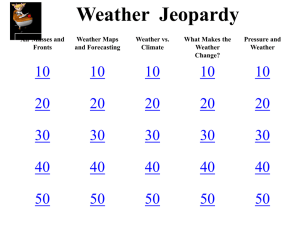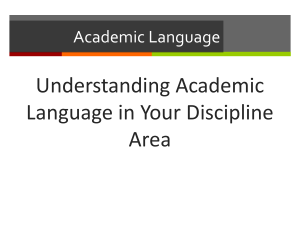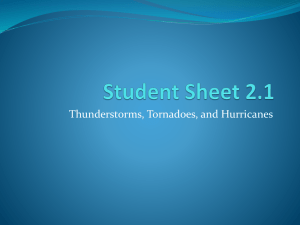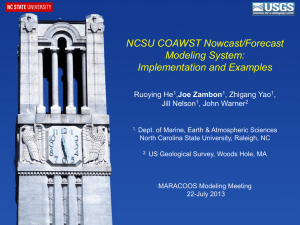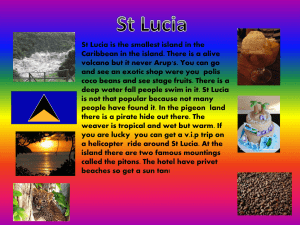EDTPA Academic Language
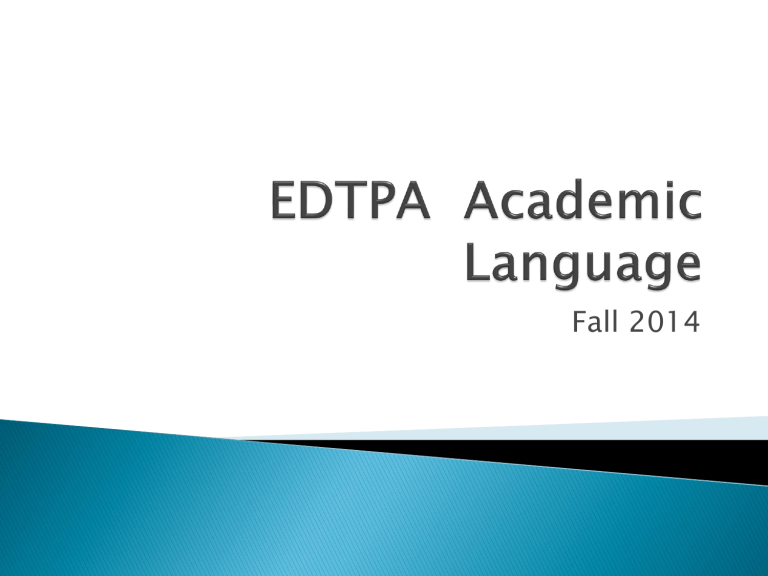
Fall 2014
School is where you go to learn a
secret language
but they don’t tell you that it’s there. You have to figure it out on your own. It’s like an initiation to a secret club.
Maya, 8 th
Language is the primary vehicle for learning , instruction , and overall intellectual development . It is not only a means for communicating information, it is also a vehicle for deepening their understanding of important ideas
.
Kersaint, Thomspon, & Petkova, 2009, p. 46.)
the language of the discipline that students need
◦ to learn and use to participate and engage in meaningful ways in the content area
the oral and written language used for academic purposes
◦ the means by which students develop and express content understandings
Academic language is the oral and written language that students need in order to
◦ understand (read, listen, think)
◦ communicate (listen, speak, write, connect)
◦ perform (think, read, write, listen, speak, solve, create)
Academic Language is necessary to participate in the content
◦ think
◦ question
◦ talk
◦ learn
So this was Excellent? Lots of traps on this one, I thought as I walked. From the line I saw the tunnel to the triple and the weave to the see-saw
– talk about discrimination! Maybe I will lead out.
Planning ahead, I would probably have to pivot or flip to get to the table. After that maybe a front cross to the double and rear cross to the walk?
That serpentine will cause problems getting her to scramble. Better hit my contact—running or target? I think this should be easier since we are at 20 now—Preferred. No MACH in our future no matter what happens today, but at least we can double Q. (p. 25)
Source: Wallace & Evans (2013)
The passage is written from a point of view of a dog trainer who is watching a 1-minute video of a dog running an agility course and talking aloud as she does so.
Academic language development is making the language of the school , content , and classroom explicit to expand students’ control over language and improve their language choices according to the purpose
( FUNCTION ) and audience for the message.
"There are three conditions required for a disturbance to form and strengthen into a hurricane. First, the disturbance must gather heat and energy through contact with warm ocean waters. Next, added moisture evaporated from the sea surface then powers the seedling tropical storm like a giant heat engine. Finally, the seedling storm forms a wind pattern near the ocean surface that spirals air inward. Bands of thunderstorms form, allowing the air to warm further and rise higher into the atmosphere. If the winds at these higher levels are relatively light, this structure can remain intact and further strengthen the hurricane."
"There are three conditions required for a disturbance to form and strengthen into a hurricane.
First, the disturbance must gather heat and energy through contact with warm ocean waters. Next, added moisture evaporated from the sea surface then powers the seedling tropical storm like a giant heat engine. Finally, the seedling storm forms a wind pattern near the ocean surface that spirals air inward. Bands of thunderstorms form, allowing the air to warm further and rise higher into the atmosphere . If the winds at these higher levels are relatively light, this structure can remain intact and further strengthen the hurricane ."
"There are three conditions required for a disturbance to form and strengthen into a hurricane. First, the disturbance must gather heat and energy through contact with warm ocean waters. Next, added moisture evaporated from the sea surface then powers the seedling tropical storm like a giant heat engine. Finally , the seedling storm forms a wind pattern near the ocean surface that spirals air inward. Bands of thunderstorms form, allowing the air to warm further and rise higher into the atmosphere. If the winds at these higher levels are relatively light, this structure can remain intact and further strengthen the hurricane."
Language used for specific purposes
◦ Inform
Identify information
Report information
Describe information
◦ Solve problems
Define problem
Represent problem
Determine solution
Language Functions
◦ content and focus of the learning task
◦ represented by action verb within the learning outcome (describing, comparing, summarizing, etc.)
ELA
Analyze
Argue
Describe
Evaluate
Explain
Interpret
Justify
Synthesize
Math
Compare/
Contrast
Conjecture
Describe
Explain
Prove
Social Studies
Analyze
Compare/
Contrast
Construct
Describe
Evaluate
Examine
Identify
Interpret
Justify locate
Science
Analyze
Explain
Interpret
Justify with
Evidence
Sentence Frames are tools that can help give students the words and the structures to use as they are initially developing fluency.
◦ Since the square root of __ is __, then __ squared must be
___. (Math)
◦ The __ is an important symbol for __ because __. (ELA)
◦ In the experiment, the __ acted on the __ and caused a
__ . (Science)
◦ The war was caused by __ , __ , and __ because __
.(Social Studies)
Specific ways that academic language is used by students to participate in learning tasks
reading
writing
listening and/or speaking
demonstrate/perform
Specific ways that academic language is used by students to demonstrate their disciplinary understanding.
What do they know?
What can they do?
What can they use language to demonstrate?
There are language demands that teachers need to consider as they plan to support student learning of content, which include:
◦ Vocabulary
◦ Language Functions
◦ Syntax
◦ Discourse
A description of the important understandings and core concepts that you want students to develop within the learning segment. The central focus should go beyond a list of facts and skills, align with content standards and learning objectives, and address the subject-specific components in the learning segment.
◦ includes words and phrases (and symbols) that are used within disciplines including:
words and phrases with subject specific meanings that differ from meanings used in everyday life (e.g., table, ruler, force, balance);
general academic vocabulary used across disciplines
(e.g., compare, analyze, evaluate); and
subject-specific words defined for use in the discipline.
Annotate
◦ In English—you add notes and/or comments to a text, usually explaining something or going deeper into the specific meaning, make connections, identify and/or explore key literary elements
◦ In Science—add brief notes to a diagram or graph
Set of conventions for organizing symbols, words and phrases together into structures (e.g., sentences, graphs,
tables)
How students organize the information needed to complete the language function.
Usually done in charts, graphs, diagrams, etc.
Examples from mathematics:
Cathy Zozakiewicz Cathy Zozakiewicz
Grammar consists of set rules regarding language and sentence structure, such as no splitting infinitives and no hanging prepositions.
Syntax, in reference to sentences, is how a sentence is worded and structured and in ways that can create, extend, or change meaning.
◦ types of sentence (declarative, interrogative, exclamatory, imperative) and
◦ word order (passive vs. active voice),
◦ length of sentences (short vs. long).
Discourse
◦ Structures of written and oral language
◦ How members of the discipline talk, write, and participate in knowledge construction
◦ How do students express the language function?
◦ Discipline-specific
Distinctive about features/way of structuring language (text structures)
◦ English
◦ Math
◦ Science
◦ Social Studies
◦ Common Core Text Types
Argument
Expository
Informational
Narrative
Writing requires something to say, the words to say it, and the structure with which to write it (McCracken & McCracken, 1986).
Teacher candidates must identify a language function essential to the central focus.
Identify a key learning task that provides students with opportunities to practice using the language function
Additional language demands
◦ Given the language function & identified task, identify associated language demands
Vocabulary
Syntax
Discourse
Language Supports
◦ Instructional supports that will help students
UNDERSTAND and USE language function & identified language
Learning
Segment
Vocabulary
Practice
Central
Focus
Key
Learning
Task
Language
Function
Syntax
Discourse
Scaffolds and
Supports
27
"There are three conditions required for a disturbance to form and strengthen into a hurricane. First, the disturbance must gather heat and energy through contact with warm ocean waters. Next, added moisture evaporated from the sea surface then powers the seedling tropical storm like a giant heat engine. Finally, the seedling storm forms a wind pattern near the ocean surface that spirals air inward. Bands of thunderstorms form, allowing the air to warm further and rise higher into the atmosphere. If the winds at these higher levels are relatively light, this structure can remain intact and further strengthen the hurricane."
Select one key language function essential for students to learn within the central focus.
Identify a key learning task from plans that provide students opportunities to practice using the language function.
Language Demands (consider language function & task) describe the language demands (written or oral) students need to understand and/or use.
Language Supports: Describe instructional supports that will help students understand and use language function & additional language demands.
Assessments: What formal and informal assessments will provide evidence of students’ understanding and fluency?
Task 1, Planning
4. Supporting English-Language Arts Development
Through Language
◦ a. Language Demand: Language Function. Identify one language function essential for students within your central focus. Listed below are some sample language functions. You may choose one of these or another more appropriate one for your learning segment.
Analyze Explain
Interpret Retell
Summarize Argue
Describe Infer
Categorize
Compare/Contrast
Predict
Question
The academic language for this learning segment is related to using and understanding informational texts. Students have read many forms of narrative texts before, but are uncomfortable with other kinds of texts. On the whole, students do not understand how text features are used, especially in informational texts , and this affects their performance in content area classes. Many students are also unaware of less commonly used text features, like white space and pronunciations in parentheses . Therefore, this learning segment will focus on defining and using these terms .
b. Identify a key learning task from your plans that provides students with opportunities to practice using the language function identified above. In which lesson does the learning task occur? (Give lesson/day/number.)
c. Additional Language Demands. Given the language function and task identified above, describe the following associated language demands (written or oral) student need to know and/or use:
Vocabulary
Plus at least one of the following:
Syntax
Discourse
In this learning segment, students will be learning about different text features that are often used in informational texts. The academic language includes white space, pictures, bullets, headings, sub-headings, captions, sidebars, maps, drawings, and graphs .
Students will also need to learn vocabulary words such as reform and intuition , which are present in the news and magazine articles that they will be reading in this unit. Students will be exposed to the academic language in a practical and engaging manner, filled with multiple opportunities to apply the new academic language across various genres of informational texts.
d. Language Supports. Refer to your lesson plans and instructional materials as needed in your responses to the prompt.
◦ Describe the instructional supports (during and prior to the learning task) that help students understand and successfully use the language function and additional language identified in prompts 4a-c.
In this learning segment, students will be supported in their use of informational text features in all of the lessons. At the beginning of each lesson, students will see the academic language in their Daily Do Nows . Students will see the new vocabulary words in a sentence and must come up with their own definitions . In all of the worksheets and graphic organizers that students will be using, key terms will be bolded .
There will also be numerous opportunities for students to discuss the terms in class .
A set of 3–5 lessons (tasks) that are
◦ logical set of lessons
◦ build on each other
◦ toward a central focus
◦ clearly defined beginning and end
Includes:
◦ activities
◦ discussions and other modes of participation that engage students
to develop, practice, and apply skills and knowledge
Learning tasks for segment
related to a specific learning goal
connected to language function for learning segment
Choose one learning task where students will need to use academic language and…
◦ Identify the academic language
Language Function (verb)
◦ Vocabulary
Identify only the vocabulary associated with the language function
Describe how/why the students will use the vocabulary or symbols/key phrases to fulfill the language function
Syntax or discourse
Clearly identify what the syntax and discourse is that students will be using to fulfill the language function
Language Supports
What will you provide to the students to help them fulfill the language function in the learning task?
Example :
◦ Learning task: Explain how Frog and Toad were alike and different.
◦ Language function: Compare and Contrast (Looking for the ways that something is like or similar to something else.
Look for the ways that something is different from something else.
◦ Supports: students in mixed ability groups working on the
Diagram on board as a visual, guided reading.
____and _____ both have ______.
Both ______ and ______ are/have ________.
_______ is similar to _______ in multiple ways because _______, ________, and _________.
Although _______is/has ______, _____ is/has
_________.
_________ is ________. However, ______ is
_________.
How will your students demonstrate their fulfillment of a language function?
